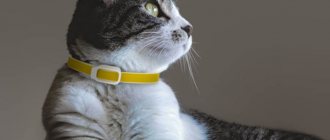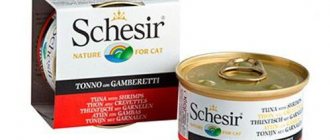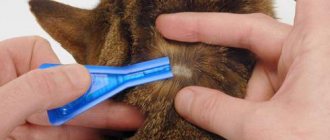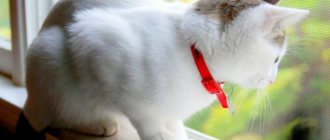General information
Before you start figuring out which flea spray for cats is best for fighting parasites, you need to understand how these products differ from each other. The main difference between the drugs is that they can be conditionally divided into two groups. The first will include those intended for processing animal hair, and the second will include products intended for treating premises.
Preparations belonging to the first group should use ingredients that are as safe as possible for the animal. However, at the same time, the flea spray for cats should destroy all the parasites that your pet has in one go and as quickly as possible. By the way, manufacturers try not to use permethrin in this product, since cats are much more sensitive to it than dogs.
For thin and sick animals, specific sprays can also be used, since due to their thin skin, some drugs may be too toxic for them.
Flea treatment products are usually sold in high concentrations and must be diluted. You can spray such preparations using a regular spray bottle.
You should not experiment and use these two types of sprays for other purposes. Otherwise, either your budget or your pet may suffer, whose health could be harmed.
Features of using flea sprays
Flea spray for cats is usually very effective and safe for the animal. If the treatment is carried out correctly, then toxic substances will not enter the pet’s body and will not cause side effects. But the treatment has a detrimental effect on fleas: they either die or leave the animal within a few minutes.
The standard application and action time of the spray is from half an hour to an hour, after which the cat should be bathed. It is recommended to select the drug depending on the age and size of the animal. They may differ in the concentration of toxic substances.
After the treatment, it is better to take your pet for a walk or distract his attention so that he does not lick himself or wash himself. After the required time has passed, the drug is washed off with running water, sometimes resorting to bathing with shampoo.
As practice shows, there is no need to re-apply the spray; fleas leave the animal’s body after the first treatment. If this does not happen, then there is a possibility that the drug was of poor quality or you did something wrong.
Flea spray "Bars" for cats: instructions
Nowadays, the choice of products for treating pets against parasites is quite large. The consumer has a fairly wide selection of the same sprays of different brands and manufacturers, produced in different countries of the world. Flea spray for cats "Bars", reviews of which are mostly positive, is gaining immense popularity among livestock breeders. The owners of their four-legged friends say that this is due to the high quality of the drug and its reasonable price. The effect is achieved literally after the first use. A can of spray lasts a long time, so this again saves your budget.
Flea spray for cats: instructions for use and recommendations for use.
Treatment should be carried out outdoors or in a very well ventilated area. At the same time, cages with birds, aquariums, etc. are removed from the room.
Avoid allowing the animal to lick the drug. For example, you can use a special muzzle.
You need to shake the bottle with the drug well, and then start spraying its contents onto the pet’s body from a distance of 30 cm.
The spray should be applied as evenly as possible. This way the maximum effect will be achieved.
One press on the head contains approximately 0.5 ml of spray. This amount is enough to process 1 kg of animal weight.
20 minutes after spraying, the cat can be combed. Repeated treatment can be carried out no less than a month later. In addition to the cat itself, this drug can also be used to treat its bed, bedding, etc. Flea spray for cats “Bars” will reliably protect your pet from annoying parasites.
DIY repellent spray
You can rid your pet of fleas using folk remedies, not forgetting that you need to treat the cat and the room at the same time. The best homemade sprays:
- 20 grams of dry wormwood are poured with two glasses of boiling water. Boil for 5 minutes, cool and filter. Pour it into a spray bottle and spray it on the cat.
- Boil chopped lemon and a bunch of lavender (20-30 minutes) in 2 glasses of water. Cool and strain. Add 2 tablespoons of witch hazel. Pour the solution into a bottle and treat the pet using a spray bottle.
It is useful to hang bunches of wormwood, tansy, and lavender indoors to repel fleas.
When choosing a treatment method, you need to remember that folk remedies for removing fleas are often no less dangerous for animals than store-bought sprays.
Sprays are a convenient way to rid your cat of fleas quickly and for a long time. They are produced from insecticides that are safe for people and animals, carefully checking the required concentration. When used correctly, they do not cause side effects. Before purchasing the product, you should consult a veterinarian and carefully read the instructions. In the future, follow preventive measures to protect your pet and home from re-infection.
Universal flea sprays
Many of those who have already faced the problem of choosing an anti-parasite drug for their pet noticed that they were also offered a flea spray for dogs and cats. Before choosing any of them, you need to know exactly for what purpose and under what conditions you will use it.
Perhaps you just want to carry out effective preventive treatment, or perhaps your pet has a mild degree of parasite infestation.
It is much more difficult if the infection is already severe. In this case, you will have to resort to using strong insecticides. But strong drugs should not be used for pregnant or lactating animals, as they can harm their health. The exception is when the animal's life is in danger.
Many pet owners take their pets out of town for the summer. In this case, you should worry about purchasing flea spray for cats and dogs in advance. You can also stock up on other preventive measures that can help prevent parasite infection.
Sprays designed to control fleas and ticks
If your pet often goes outside or you live outside the city, then in addition to fleas, there is also a threat of ticks. These parasites, in addition to sucking animal blood, also carry various types of dangerous diseases. Some of them can be fatal. To prevent trouble and preserve the health of your pet, it is better to carry out treatment in advance. Flea and tick spray for cats can help control many types of parasites. The owners of their four-legged friends say that it is these drugs that have the most effective effect and are most popular among livestock farmers. According to cat owners, due to its wide spectrum of action, they eliminate the need to buy several medications. This saves not only money, but also time and nerves, which is important for animal lovers.
Currently, the industry produces universal sprays that can fight both fleas and ticks. However, they should be selected especially carefully, taking into account the weight and biological characteristics of the animal. It is important to pay attention to the fact that he does not have allergic reactions to the components indicated in the composition of the drug.
As a preventative measure, you can treat not the animal itself, but its habitat, with such a spray. However, this is only if the pet does not live on the street.
Flea spray for cats, the reviews of which are positive, is produced by “Clandestine”, “Bars”, etc.
The best flea treatments for animals
The modern market of veterinary preparations is ready to offer a variety of insecticidal and acaricidal preparations that differ in effectiveness, mode of action, and use. In any pet store, veterinary pharmacy or clinic you can purchase an effective domestic or foreign product to kill fleas, ticks, and lice that parasitize the body of our beloved pets.
Flea remedies for cats
If the owner of a furry purr is faced with the task of protecting his pet from fleas and other types of dangerous ectoparasites, it is enough to simply use the given tips for choosing the most effective insecticidal veterinary products.
For the prevention and destruction of dangerous ectoparasites from our little brothers, the following is used:
recommended articles:
- Grooming a cat, is it worth using scissors?
- Papillomas and warts in cats
- insecticidal and acaricidal drops;
- sprays;
- aerosols;
- pills;
- flea powder;
- special shampoos;
- anti-flea collars.
Important! The least allergenic and toxic for animals are antiparasitic shampoos, insecticidal acaricidal aerosols, and powders.
For preventive and therapeutic purposes, a good effect is noted after using special drops on the withers, shampoos, sprays, aerosols. Such products have a gentle effect, are safe for the health of animals and at the same time repel fleas and ticks, and quickly destroy ectoparasites living on the body of a pet.
Effective anti-flea products for animals should be easy to use, absolutely safe for pets, and provide quick, long-term, good results.
Most antiparasitic drugs have a complex spectrum of action. Provide protection and destroy ecto- and endoparasites at all stages of their development. Used for the treatment of otodectosis, flea dermatitis, and demodicosis. The duration of protection depends on the components of the veterinary preparation, their concentration, and the properties of the main active ingredients.
Modern flea treatments for cats use various types of insecticides: fipronil, ivermectin, pyriproxyfen, imidacloprid, nitenpyram, peritrin. The listed components are safe for cats and humans, and have a high degree of effectiveness. Nitenpyrami-based products can be used to treat the coat of pregnant cats.
Drops on the withers for cats against fleas
Flea drops are a universal, convenient insecticide. Used for the prevention and treatment of flea infestations. Apply to the withers, between the shoulder blades, along the spine. After application, distribute evenly throughout the body. In rare cases, they provoke allergic reactions and other side effects.
Treatment of cats against fleas with drops
Aerosols, flea sprays
In case of severe infection of a cat with ectoparasites, it is best to treat the pet’s fur with aerosols, sprays, solutions, and emulsions.
Sprays, which can be classified as the most powerful, active insecticidal agents, almost immediately after use destroy ectoparasites - fleas, lice, lice, ticks. Suitable for instantly getting rid of insects that parasitize the body of warm-blooded animals. Provide long lasting protection. Convenient to use.
Aerosol for cats against fleas
Important! They are highly toxic, so precautions should be taken when working. Read the instructions carefully before use.
Do not use for treating the fur of sick, severely weakened, emaciated animals. It is strictly not recommended to use for small kittens up to two to three months of age, or for removing fleas from pregnant and lactating females.
They can be used not only to combat parasitic insects on the body of animals, but also to treat apartments, litter, and cat houses.
Anti-flea collars
Insecticidal collars are generally designed to prevent flea infestations in pets. other types of ectoparasites. Experts recommend using them as additional protection, especially if the cat roams freely on the street.
Flea collars can also be used to get rid of ectoparasites, but only in cases of mild infestation.
An anti-flea collar is an excellent preventative against ectoparasites for cats.
Allergy to flea spray
Flea spray for cats can cause an allergic reaction in an animal if it is intolerant to the components of the drug. If after treatment you notice changes in your pet’s behavior, redness on the skin, itching, scabies, you should contact a veterinary clinic and consult for allergic reactions in the cat’s body. If the assumptions are confirmed, the doctor will prescribe treatment and give an injection, but in the future you will need to carefully select the composition of anti-flea medications and avoid those that contain an allergen.
An allergy to flea spray can also occur in a more severe form, so during the first treatment you need to be very careful and monitor the slightest changes in the animal’s usual behavior.
Contraindications and possible side effects
Despite all the benefits of anti-flea sprays for cats, this form of the drug requires special caution when used. Failure to carefully study the instructions may cause intoxication of your pet. In terms of ease of dosing, sprays are inferior to drops, collars, and tablets against blood-sucking parasites. For this reason, this form of insecticide is not suitable for pregnant, sick, lactating individuals, or kittens under 2-3 months. It is quite difficult to select the optimal dosage, taking into account such physiological characteristics of the cat and maintaining effectiveness against fleas.
If spray particles get into the respiratory tract, mucous membranes or stomach of an animal, signs of poisoning may appear. It is believed that spray bottles are less dangerous to a cat’s health than aerosols, which form a cloud of fog and easily penetrate the pet’s respiratory tract.
Contraindications to most flea sprays include:
- individual sensitivity, allergies to components,
- periods of pregnancy and lactation,
- age up to 2–3 months and body weight less than 1 kg,
- diseases of internal organs, acute and chronic,
- skin diseases, dermatitis,
- recovery period after illness.
The most common side effects when using flea spray are signs of intoxication and allergies:
- vomiting, refusal to feed,
- weakness and drowsiness,
- diarrhea,
- hair loss,
- itching, rash and redness of the skin,
- impaired coordination of movements.
Most often, negative reactions after using the spray are observed when the dosage is not observed and the insecticide gets into the animal’s stomach.
Indoor flea spray
If your pet has become infected with parasites and you have treated its body with special preparations, you should not stop there. The fact is that, most likely, the parasites have already managed to migrate to the habitat of the cat or dog, and perhaps even lay larvae there. In order to finally get rid of this scourge, it is necessary to treat the room.
When choosing a spray to treat a room, you need to pay attention to qualities such as composition, toxicity, and method of application. However, price will also play an important role in the final choice. There is no need to overpay extra money, however, there is also no need to choose the cheapest flea spray for cats, because it is more likely to save on quality.
It is known that fleas, similar to linen lice, are very hardy and are able to hide in inaccessible places. That is why it is advisable to use a spray to treat the room. In this case, processing is carried out in several stages.
First, general cleaning is carried out, as a result of which some insects are removed. After this, animals and people are removed from the apartment. You should also remove food and laundry.
Before using flea spray for cats, be sure to read the instructions for use. If necessary, shake the can and begin processing. Particular attention should be paid to the floor and surfaces near it. Also, you should not ignore hard-to-reach places (cracks, baseboards, etc.).
A few hours after the treatment, the room is thoroughly ventilated and cleaned again. After a week, it is recommended to carry out another treatment of the room. It will help get rid of those parasites that were hatched after the initial treatment.
Sprays for treating rooms and objects
Fleas live not only on cats; they infect with their larvae and eggs everything the animal comes into contact with. Without simultaneous and thorough treatment of the entire apartment, it will not be possible to cure cats forever.
Room sprays are convenient and economical. They are highly active, contain several active components, are easy to spray, and reliably eliminate fleas from upholstery and nooks and crannies. The main thing when using is a systematic approach and thorough spraying on all surfaces without excess or soaking objects.
Noroclin extra
A convenient product for cleaning an apartment from insects. Ingredients: methoprene, permethrin.
Quickly kills fleas and larvae, prevents re-infection for up to six months. When using, follow the usual safety requirements (removing animals and people, ventilating the home after treatment, washing surfaces, washing cat bedding and rugs).
Combat
The Combat group of drugs includes drugs of varying strengths. Contains insecticides imiprotrin, cyphenothrin, strong and highly effective, used for severely infested premises.
Combat is suitable for soft surfaces, it does not damage fabrics, evaporates quickly, losing dangerous activity after killing insects.
Clean house
Domestic flea remedy. One bottle is enough to treat an area of 80 square meters. Active ingredients: cypermethrin, tetramethrin.
The spray does not affect eggs and requires re-spraying after a week. Low toxicity for people and animals. After disinfection of the home, thorough wet cleaning is necessary.
Other effective means for cleaning rooms include Executioner, Flee, Beaphar, Raptor.
Safety rules during processing
In order to protect yourself from the effects of insecticides, it is necessary to use personal protective equipment against chemicals. You should also avoid direct contact of poisons with the skin, eyes, nose, mouth, etc. This can cause significant poisoning. You should try to inhale the spray as little as possible and not be in the treated room. After carrying out all activities, wash your hands thoroughly with soap.
When carrying out treatment, you need to ensure not only that the poison does not enter your animal’s body, but also your own and your loved ones. It is for this purpose that the listed safety rules should be followed. Some sprays have a high concentration of toxic substances, and therefore can harm health and cause changes in well-being. In case of severe poisoning, it is better to consult a doctor or call an ambulance. Under no circumstances should you ignore the corresponding symptoms; the consequences can be very, very negative. If you notice changes in the behavior of your household, you should also not ignore this: perhaps they simply do not attach importance to the onset of serious poisoning.
Basic compliance with safety rules will help preserve the life and health of you and your pets.
How to remove fleas from a cat
- Treatment against fleas and ticks in cats should be carried out at least once every 3 months, and if your cat is outdoors and in contact with other animals, then at least once every 1-2 months.
- 3 days before and 3 days after the procedure, bathing the animal is prohibited, unless this is required by the method of applying some drops to the withers.
- It is important to use products designed specifically for cats. Because some anti-flea medications for dogs are toxic to felines.
- Without consulting a specialist, you should not use flea and tick medications on newborn kittens, pregnant and lactating cats, as well as weakened and sick animals.
- After treating the fur with sprays and drops, do not let the animal lick itself for about half an hour. To be safe, use an Elizabethan collar - this way the cat will definitely not be able to lick anything.
- It is necessary to treat not only the pet with special products, but also the places where it sleeps (house or lounger) and plays (play set, scratching post). It is also important to thoroughly vacuum surfaces that cannot be washed: sofas, armchairs, ottomans, carpets.
How to use flea treatments correctly
The effectiveness of flea medicine is influenced by the correct use of it, namely:
- three days before and three days after treatment, you cannot bathe the cat;
- correct application of the product not to the cat’s fur, but to the skin in the withers area and along the part of the spine that the animal cannot lick;
- maintaining the correct dosage of the drug.
The dosage is calculated based on the weight and age of the animal in accordance with the recommendations on the packaging of a particular product.
Do not exceed the recommended dosage - the products are toxic!
To effectively control fleas, you should take into account the life cycle of these insects and know that on average, 5% of adult fleas live on a cat.
Flea eggs (50%), larvae (35%) and pupae (10%) are found not only on the animal’s body, but also in the environment. That is why it is necessary to treat not only the animal, but also its habitat. It is best to completely replace the bedding and all care items.
Further in the article we will look at the types of flea products and their popular brands. Let's compare their characteristics and prices. Let's talk about traditional methods of fighting parasites.
How to get rid of fleas on a pregnant or lactating cat
Excellent health of a pregnant or lactating cat is a prerequisite for the birth of a healthy and viable litter. Fleas not only release toxins into the animal's blood, forcing the cat to scratch the bite sites, but also increase the risk of infection with helminths, as well as a number of infectious diseases.
The use of standard treatments in this situation should be approached with extreme caution; flea sprays, drops or other drugs may have a negative effect on fetal development or affect the quality of milk.
One of the most effective and simplest methods is to simply wash the cat while combing the fur with a fine-toothed comb. If you find fleas between the teeth of the comb, you should rinse the tool with hot water.
This method of fighting parasites will require a fair amount of patience and perseverance from the owners, since the procedure requires regular frequent repetition and one cannot count on quick results.
Antiparasitic shampoos can be used to treat a nursing cat, but you should consult your veterinarian before choosing a product. When using such shampoos, special attention should be paid to rinsing the cat, since even slight residues of foam on the nipples can lead to health problems for kittens.
Do not neglect folk remedies. For example, a decoction of rosemary applied to a cat’s fur significantly reduces the number of parasites. An excellent remedy for fleas is wormwood, and you can use a fresh plant, dried or wormwood oil. Wormwood does not kill fleas, but its smell can repel parasites.











